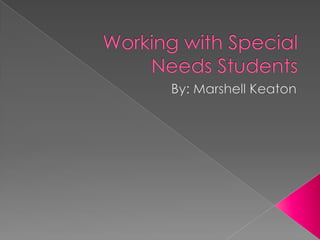
Working with special needs students
- 1. Working with Special Needs Students By: Marshell Keaton
- 2. Introduction Teaching special needs students can be a difficult process, that requires a lot of hard work and understanding. Special needs students include children with learning disabilities, attention deficits, developmental delays, behavioral problems, or other distinctive disorders. One reason why educating special needs students is often so complex is because there are many different issues involved including Federal laws such as the IDEA, No Child Left Behind (NCLB), and Section 504 of the Rehabilitations Act of 1973. It is important to understand these laws while educating special needs students because the laws can affect classroom management and require for inclusion and instruction to take place in the least restrictive environment (LRE).
- 3. Introduction Cont. There are many technologies and strategies that can be used to effectively educate special needs students, and it is important for teachers to study and develop the best methods to reach their students’ individual needs. Some experts suggest that alternative teaching methods, accommodations, and assistive technologies be used to improve students’ weaknesses. After reviewing a student's disability, it is up to the educator to customize an individual educational plan (IEP) that will reach each student effectively using these technologies and strategies.
- 4. Key Terms IDEA-Individuals with Disabilities Education Act is a United States federal law that governs how states and public agencies provide early intervention, special education, and related services to children with disabilities. No Child Left Behind (NCLB)- act of Congress that promotes standards-based education. Section 504 of the Rehabilitations Act of 1973 -federal law designed to protect the rights of individuals with disabilities in programs and activities that receive Federal financial assistance from the U.S. Department of Education Inclusion-a term which expresses commitment to educate each child, to the maximum extent appropriate, in the school and classroom he or she would otherwise attend. Least Restrictive Environment (LRE)-area where disabled students have a right to be educated with non-disabled peers, to the greatest extent appropriate. Assistive Technology- technology used by individuals with disabilities in order to perform functions that might otherwise be difficult or impossible. Individualized Education Plan (IEP)- the legal document that defines a child's special education program.
- 5. Guidelines to choosing Assistive Technologies and Strategies It is important to examine the interests, abilities and needs of a child and the area where support is needed, so that assistive technology solutions can be planned and implemented effectively. The following six steps will assist you in choosing the appropriate technology based on your students’ specific needs. Steps are explained more in depth at http://www.ldonline.org/article/8088. Step 1: Collect child and family information. Step 2: Identify daily activities that student participates in. Step 3: List observations that can be used to indicate whether or not the intervention is successful. Step 4: Brainstorm assistive technology solutions and alternative teaching strategies. Step 5: Determine when the assistive technology intervention or strategy will begin and create an observation plan to record how the child participates with the technology or new teaching method. Step 6: Identify what worked
- 6. Types of Assistive Technologies The Touch Window-ideal for students who have trouble using the computer’s mouse. Effective with preschoolers, early learners, and students with developmental or physical disabilities. FM systems & Induction loop systems- assistive listening devices The invisible clock- used with ADHD students that have trouble with time management. Portable word processors, audio books and speech recognition programs- can be used with students diagnosed with ADHD and mild reading and writing disabilities.
- 7. Non-Technological Instructional Practices For students who are deaf or hard of hearing: 1. Circular seating arrangements so students can see all class participants 2. Repeat comments and questions, acknowledging the students who made them 3. Provide written transcripts of audio material
- 8. Non-Technological Instructional Practices Cont. For students with mild learning disabilities including reading and writing: 1. Instruction should be presented in both written and oral formats 2. Allow students to record class 3. Clearly define course requirements, the dates of exams, and assignment due dates 4. Provide handouts and visual aids 5. Use more than one way to demonstrate or explain information
- 9. Non-Technological Instructional Practices Cont. For students with mild learning disabilities including reading and writing: 6. Have copies of course reading list ready in advance, so that taped textbooks can be ordered for students with mild learning disabilities including reading and writing. 7. Break information into small steps 8. Allow time for clarification of directions 9. Provide assistance with proofreading written work 10. Computer access for essay exams 11. Reduce distractions during exams.
- 10. Non-Technological Instructional Practices Cont. For students with ADHD: 1.Provide an advanced organizer. 2. Set learning and behavioral expectations. 3. State needed materials. 4. Simplify instructions, choices, and scheduling. 5. Support the student's participation in the classroom. 6. Use audiovisual materials. 7. Check student performance. 8. Ask probing questions. 9. Perform ongoing student evaluation. 10. Help students correct their own mistakes.
- 11. Non-Technological Instructional Practices Cont. For students with ADHD: 10. Help students correct their own mistakes. 11. Help students focus. 12. Provide follow-up directions. 13. Lower noise level. 14. Divide work into smaller units. 15. Highlight key points. 16. Eliminate or reduce frequency of timed tests. 17. Use cooperative learning strategies. 18. Check assignments.
- 12. References Assistive Listening Devices http://www.asha.org/public/hearing/treatment/assist_tech.htm ADHD and Assistive Technology http://www.brighthub.com/education/special/articles/74108.aspx ADD / ADHD and School: Helping Children with ADHD Succeed at School http://helpguide.org/mental/adhd_add_teaching_strategies.htm Guidelines to choosing Assistive Technology http://www.ldonline.org/article/8088 Special Education http://en.wikipedia.org/wiki/Special_education Successful Strategies for Teaching Students with Learning Disabilities http://www.ldanatl.org/aboutld/teachers/understanding/strategies.asp Strategies for Teaching Students with Hearing Impairments http://www.as.wvu.edu/~scidis/hearing.html Touch Window http://www.synapseadaptive.com/edmark/prod/tw/default.htm Teaching Students with Special Needs http://www.teachervision.fen.com/special-education/new-teacher/48460.html